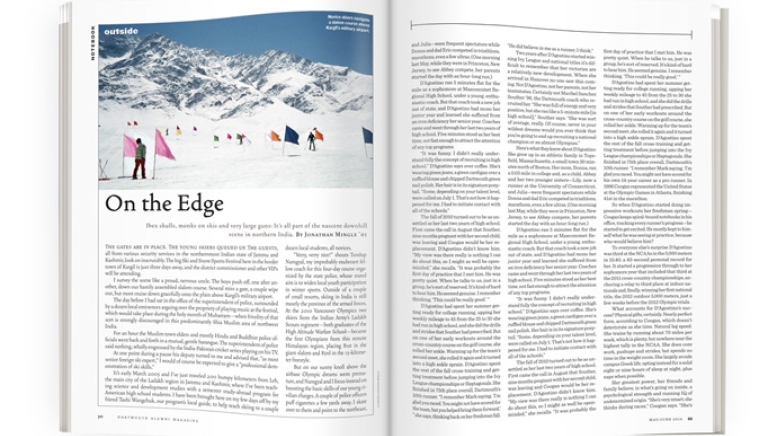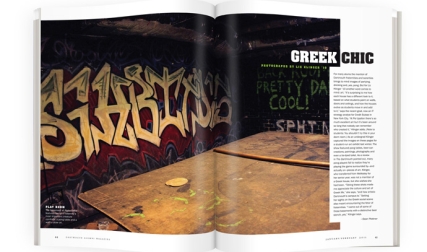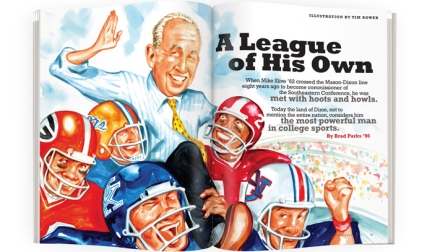The gates are in place. The young skiers queued up. The guests, all from various security services in the northernmost Indian state of Jammu and Kashmir, look on inscrutably. The big Ski and Snow Sports Festival here in the border town of Kargil is just three days away, and the district commissioner and other VIPs will be attending.
I survey the scene like a proud, nervous uncle. The boys push off, one after another, down our hastily assembled slalom course. Several miss a gate, a couple wipe out, but most cruise down gracefully onto the plain above Kargil’s military airport.
The day before I had sat in the office of the superintendent of police, surrounded by a dozen local eminences arguing over the propriety of playing music at the festival, which would take place during the holy month of Muharram—when frivolity of that sort is strongly discouraged in this predominantly Shia Muslim area of northwest India.
For an hour the Muslim town elders and mostly Hindu and Buddhist police officials went back and forth in a mutual, gentle harangue. The superintendent of police said nothing, wholly engrossed by the India-Pakistan cricket series playing on his TV.
At one point during a pause his deputy turned to me and advised that, “as most senior foreign ski expert,” I would of course be expected to give a “professional demonstration of ski skills.”
It’s early March 2005 and I’ve just traveled 200 bumpy kilometers from Leh, the main city of the Ladakh region in Jammu and Kashmir, where I’ve been teaching science and development studies with a semester study-abroad program for American high school students. I have been brought here on my few days off by my friend Tashi Wangchuk, our program’s local guide, to help teach skiing to a couple dozen local students, all novices.
“Verry, verry nice!” shouts Tundup Namgyal, my improbably exuberant fellow coach for this four-day course organized by the state police, whose stated aim is to widen local youth participation in winter sports. Outside of a couple of small resorts, skiing in India is still mostly the province of the armed forces. At the 2010 Vancouver Olympics two skiers from the Indian Army’s Ladakh Scouts regiment—both graduates of the High Altitude Warfare School—became the first Olympians from this remote Himalayan region, placing 81st in the giant slalom and 83rd in the 15-kilometer freestyle.
But on our sunny knoll above the airbase Olympic dreams seem premature, and Namgyal and I focus instead on boosting the basic skills of our young civilian charges. A couple of police officers puff cigarettes a few yards away. I skate over to them and point to the northeast, where a craggy peak rises above a gentle but enticing gully.
“Can we take some of the better students and see if that’s worth skiing?” I ask. One of them glances at the mountain.
“Oh, certainly,” he says. He seems amused by my suggestion. “On top is one of the big guns we use to fire on Pakistan.”
“Big guns, eh?” I say. “Or we could just stay down here. The skiing here is fine, actually.” The officer shrugs.
When I think about how I get into these situations, I tend to blame Dartmouth. When people used to ask me why I was going to the College I would say, only half-jokingly, “for the skiing.” Sure it’s a great school, I acknowledged, with challenging classes, gifted professors, small-town charm, that powerful, famous sense of place. But I would also happily tally all of the great ski venues within a two-hour drive. Over my four years, aided and abetted by like-minded friends and cold fronts sweeping down from Canada, I explored most of them. I took my junior winter off to be a ski bum in Colorado. During my senior winter I finally found my spiritual ski home, making the most of a lean Tuesday-Thursday class schedule, a record snowfall and a season’s pass to Mad River Glen.
Whether due to a deficit of talent or ambition or, most likely, both, I never got into competitive skiing. Instead, skiing became for me synonymous with freedom, with breaking constraints. During sophomore year I took a P.E. course in telemark skiing, taught with haphazard élan by instructor Jed Eliades. As he led us over hill and dale, Jed drilled us in the basics of “freeing the heel.” His unflagging enthusiasm often seemed only loosely connected to the events unfolding on the slope. This proved to be a formative experience—and the beginning of a backcountry skiing habit I probably won’t be able to kick until my knees call it quits.
The addiction grew strong enough that I wound up bringing my gear along on multiple trips to the Indian Himalayas as a teacher with the study-abroad program. Our field visits and home-stays often took us over 16,000-foot passes, so I’d take every opportunity to throw my telemark skis under the bus seats or over my shoulder and carve some terra incognita.
This occasionally involved dodging half-submerged ibex skulls and answering a lot of incredulous questions from local villagers. I skied past burnt-out wrecks of tumbled army transport trucks far below precipitous roads and down narrow frozen creek beds that brought to mind the Mount Moosilauke carriage road. I developed an attenuated, cautious technique out of respect for the considerable distance to primary healthcare.
I discovered that there are corners of India where people are, believe it or not, as hungry for skiing as Dartmouth students. On my first trip in 2003 I became involved with a remarkable organization called the Zanskar Ski School (ZSS), which promotes skiing as a mode of transportation, communication and recreation during long winters in the remote valley of Zanskar, south and east of Kargil. Heavy snows cut off Zanskar and its one rutted road from the rest of the world for up to seven months a year. For decades, in a largely treeless landscape, people would jury-rig homemade skis from frozen hosepipe or castoff packing crates, lashing them to their shoes with baling wire or leather. Then ZSS came along, with donated equipment and tailored instruction.
On several subsequent visits I’ve watched with pleasure as ZSS students, boys and girls, Muslims and Buddhists, government officials and 4-year-olds alike, exclaim with delight as they step into skis and make that first tentative push down a slope into the unknown. Skiing has become for them a new freedom in a demanding environment.
I’ve had some great runs in some of India’s high places, skied with some wonderful people and managed to stay out of too much trouble. But at no point, alas, did I become a “most senior foreign ski expert.”
On the hills above Kargil, however, the VIPs do not know this. Namgyal has formed a line of students and is coaching them on proper army-style inner-tube-riding technique. Namgyal sends another merry youth on his spinning way and turns to remind me, with aplomb, that he, a winner of six medals at the 2005 Asian Games, and I are expected to ski at the festival along with our students. “Right,” I nod.
As the boys continue their inner-tube antics, I figure this lull in the training offers a good opportunity to practice. I point my tips down the steepest face of the hill. All eyes turn to me. And sure enough, I’m in a groove, linking smooth telemark turns, knees churning like pistons—until, halfway down, my boot suddenly pops out of one of my bindings. I face-plant. Hard. Unceremoniously. The ski shoots off toward Pakistan.
I pick myself up, sheepishly corral the rogue ski, click back in and finish my run. Pulling up at the bottom I grin apologetically at the stone-like faces of the assembled police and army officers. One of them is definitely frowning.
A cheerful shout pierces the silence, like echoes on a hill in Etna far, far away. “Verry, verry nice!” cries Namgyal. “First class!”
Jonathan Mingle lives in Vermont, where he writes, skis and consults on sustainability education programs in New England and the Himalayas.




